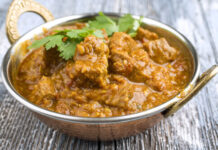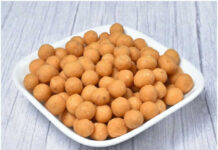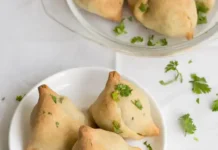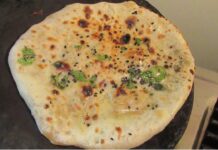Gujiya is a traditional Indian sweet pastry that is commonly prepared during festivals like Holi and Diwali. It is made by stuffing a sweet filling into a dough pocket and deep-frying until golden brown. Here’s the recipe:
Preparation time: 30 minutes
Cooking time: 20 minutes
Ready in: 50 minutes
Ingredients:
For the dough:
- 2 cups all-purpose flour (maida)
- 4 tablespoons ghee or clarified butter
- Water as needed
For the filling:
- 1 cup grated khoya (mawa)
- 1/2 cup powdered sugar
- 1/2 cup chopped mixed nuts (cashews, almonds, pistachios, etc.)
- 1/4 cup desiccated coconut
- 1/2 teaspoon cardamom powder
- 1 tablespoon rose water (optional)
- Oil for deep frying
For garnish:
- Saffron strands (optional)
- Chopped pistachios or silvered almonds
Instructions:
- In a mixing bowl, combine the all-purpose flour and ghee. Mix well until the flour resembles bread crumbs.
- Gradually add water, little by little, and knead to form a smooth and firm dough. Cover the dough with a damp cloth and set it aside for 15-20 minutes.
- Meanwhile, prepare the filling. In a pan, heat the khoya on low heat until it softens and starts to melt.
- Add the powdered sugar, mixed nuts, desiccated coconut, cardamom powder, and rose water (if using). Mix well until everything is combined. Remove from heat and let the filling cool.
- Divide the dough into small portions and roll each portion into a thin circular disc, similar to a puri.
- Place a spoonful of the filling in the center of each disc. Fold the disc in half and seal the edges by pressing them together with your fingers or using a fork.
- Heat oil in a deep pan or kadai for frying. Once the oil is hot, gently slide in the gujiyas and fry them on medium heat until they turn golden brown and crispy.
- Remove the fried gujiyas from the oil and drain them on a paper towel to remove excess oil.
- Allow the gujiyas to cool completely before serving. Garnish with saffron strands and chopped pistachios or silvered almonds.
Gujiyas can be stored in an airtight container for several days. They are best enjoyed as a sweet treat with a cup of tea or served as a dessert during festive occasions.



















